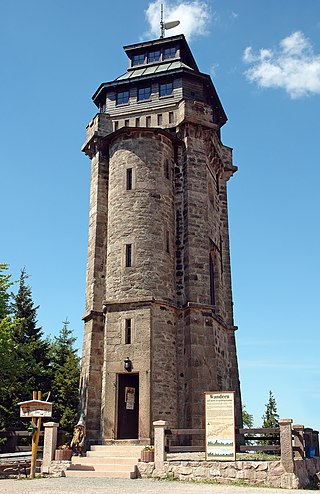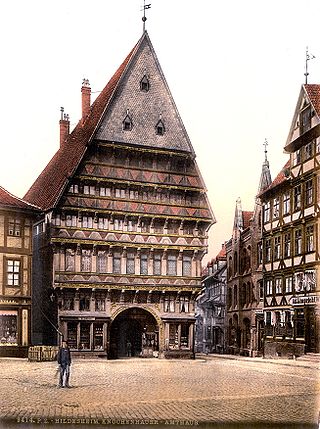
The Gothenburg opera house is an opera house at Lilla Bommen in Gothenburg, Sweden. The Artistic Director for opera is Henning Ruhe since 2019, while Katrín Hall leads the ballet and dance company.

The Feldberg/Taunus transmitter is a facility for FM- and TV-broadcasting and for directional radio services located on the Großer Feldberg, the highest mountain in the Taunus region of Germany.

The Joseph Cross is an observation tower in form of a double cross on the 580-metre-high Großer Auerberg near Stolberg (Harz), Germany. The Joseph Cross is a steel framework construction with a height of 38 metres and a weight of 125 tons, which was built between 20 April 1896 and 9 August 1896. The Joseph Cross was closed for visitors from 1987 to 1990, before being refurbished and reopened.

An observation tower is a structure used to view events from a long distance and to create a full 360 degree range of vision to conduct long distance observations. Observation towers are usually at least 20 metres (66 ft) tall and are made from stone, iron, and wood. Many modern towers are also used as TV towers, restaurants, or churches. The towers first appeared in the ancient world, as long ago as the Babylonian Empire.
Radio masts and towers are typically tall structures designed to support antennas for telecommunications and broadcasting, including television. There are two main types: guyed and self-supporting structures. They are among the tallest human-made structures. Masts are often named after the broadcasting organizations that originally built them or currently use them.

The Blumenthal Observation Tower is a 45 metre tall observation tower built of wood in Blumenthal, part of the municipality Heiligengrabe, Brandenburg, Germany.

The Wil Tower is a wooden observation tower which was built in the forest of Wil in Switzerland by Julius Natterer. The tower site is located some 747 metres (2,451 ft) above sea level. It was opened for public use on 8 July 2006.

Pyramidenkogel is an 851-metre-high (2,792 ft) mountain in Carinthia, Austria. It is located to the south of the Wörthersee and near the town of Maria Wörth, in an area that is a boundary between speakers of German and Slovenian. In nearby Slovenia the mountain is known as Jedvovca. The mountain has been a tourist attraction since at least the late 19th century. The view from its top is mentioned in Karl Baedeker's 1879 The Eastern Alps.

Hochheideturm is a 59-metre-high (194 ft) observation tower, with a completely glassed prospect platform on 831 metres high, located in Ettelsberg, Germany, near Willingen. The northwest side of the tower is the highest artificial climbing wall of Europe.

The Butchers' Guild Hall is a half-timbered house in Hildesheim in the federal state of Lower Saxony, Germany.

The Steinkopf near Ober-Rosbach in the county of Wetteraukreis and Pfaffenwiesbach in the county of Hochtaunuskreis in the German state of Hesse is a hill, 518 m above sea level (NHN), in the eastern Taunus and the easternmost Taunus eminence over 300 m. It has an isolation of 10.170 km and a prominence of 173 m and is thus one of the five independent summits in the Taunus. The Steinkopf is a landmark visible from a long distance especially for the immediately adjacent region of Wetterau to the east.
The Wilhelm Raabe Tower is one of the few surviving Kaiser towers (Kaiserwarten). It is located on the Eichenberg hill near Blankenburg on the edge of the Harz Mountains of central Germany. It is owned by the Harz Club branch in Blankenburg. It was built in 1896 in honour of Wilhelm II, the German emperor and King of Prussia and is one of the few surviving Emperor Towers.

Heiligenstock Transmitter, also known as the Heiligenstock Radio Tower, was a wooden German lattice transmitter that was used for mediumwave broadcasting. The tower was built in the year 1934 but was dismantled four years later because of its bad state. The tower was then rebuilt the same year it was dismantled in the city of Frankfurt. The newly rebuilt radio tower was then demolished on March 25, 1945 during the Second World War by the retreating German troops using explosives. It was 107 metres tall.

Idarkopf Tower, also known as Idarkopf Observation Tower for long, is a wooden German lattice observation tower on the summit of Mt. Idarkopf in the state of Rhineland-Palatinate. The observation tower on the 746 m-high (2,448 ft) mountain of Idarkopf has a total height of 28.50 m (94 ft). Built in 1980, the tower was constructed according to a certain kind of specialized wooden frame and was designed through triangular sketch. Staircases are uncountable because of the vast number of steps. The roof, which contains the observation deck, is considered the highest accessible point in the whole area, providing a unique view of the town nearby.

The Aschberg is a hill, 98 m above sea level (NN), in the Hütten Hills Nature Park in Schleswig-Holstein, Germany. In good weather, the view reaches as far as the Baltic Sea. The Nature Park Way, which links five nature parks in Schleswig-Holstein for ramblers, runs over the Aschberg.

Alte Brücke is a bridge in Frankfurt, Hesse, Germany. It is the oldest bridge over the lower course of the river Main, and until 1886 was the only stone bridge crossing the river. From the Middle Ages until the year 1914, it connected the "Fahrgasse" in Frankfurt Altstadt with the "Brückenstraße" in Sachsenhausen. Since its first mention in official documents in 1222, the development of Frankfurt has been strongly influenced by the bridge. Over the centuries, Alte Brücke has been destroyed and reconstructed at least 18 times. With its 13 brick-built circular arches, the Sachsenhausen Bridge was one of the most prominent buildings of the city, but failing to meet the increasing demands of the modern road and ship traffic, it was demolished in 1914.

The Treetop Walk Saarschleife is a 1,250 meter long canopy walkway in the Orscholz area of Mettlach, Germany. Built atop a rocky vantage point known as the "Cloef", it offers visitors views of the Saarschleife. The major Saarland tourist attraction is operated by "Erlebnis Akademie AG."

The Church of St Peter is a former evangelical church located in the Innenstadt area of Frankfurt, Germany. It has been known as jugend-kultur-kirche sankt peter since 2007, when it became a youth centre.

















